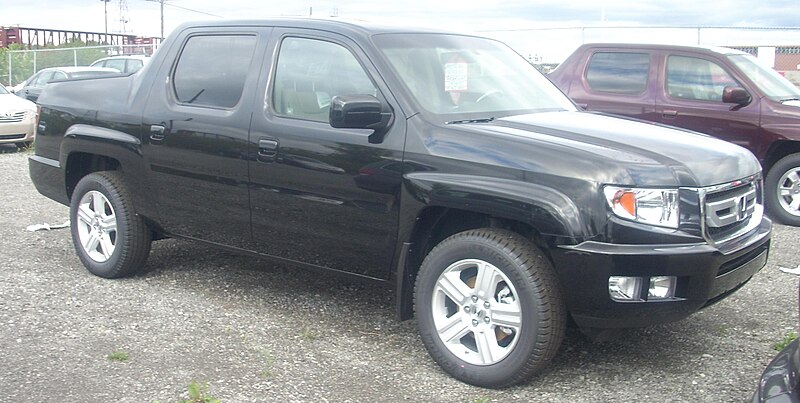_____
Since I named it after the ship from Star Trek -- Deep Space Nine,
maybe
 it should be called the Defiant II...
it should be called the Defiant II...I got it about 4 years ago and barely got to enjoy driving it. The starter motor housing would become magnetized, immobilizing the motor itself. A couple dozen taps with a ball peen hammer were required for degaussing before it would start, almost every time.
Then one day it acted like it was starving for fuel -- and I thought I'd just found the spot on the gauge that meant the tank was seriously empty, and felt lucky to be able to coast to a pump...
NO. It had been sitting for years before I traded it for a six-pack of Guinness and had it flatbedded to a shop where the fuel system was cleaned out. Apparently they missed something. My best guess is that there's a clog in one or more of the injectors...
AAAAAAAnyway so the 1981 Toyota Cressida I call the DEFIANT has been sitting on the street in front of my house since then, slowly deteriorating while I've dreamt of converting it to electric. As an electric car, it would never have fuel or starter trouble.
NOT SO FAST.
I don't mean it wouldn't be as quick after such a conversion. I mean, recently I've been rethinking this...
More and more people around the world have been experimenting with GEET systems, and with 'HHO', with a certain amount of success. Some of them document their successes on YouTube -- meaning that these days, it's much easier to get an idea of how to take advantage of these alternative technologies.
A GEET system, simply put, adds water to the air/fuel mixture. With each combustion cycle of each cylinder, the water turns to steam -- and that expansion would be plenty, by itself, to run the engine. Of course you still need fuel, but you use much, much less (and emissions are greatly reduced).
Really, if I could just get my Cressida running again, without any starter trouble or fuel clog worries, that would make me pretty happy. Totally doable, and would have been done a long time ago if I didn't have something else to drive -- but I guess there hasn't been enough motivation...
'HHO' is simply H2O split into its basic elements. THIS IS NOT HARD TO DO, has in fact been done since the 1830s. If you make colloidal silver and have seen bubbles on your electrodes, those are bubbles of hydrogen on one and oxygen on the other...! All it takes is electricity and water, basically...
You may see fancy generators made with stainless steel cylinders arranged 'just so' -- but it doesn't have to be that complicated. I won't get into the details here, as I am not (yet) an expert, but I've seen a convincing demonstration (just search YouTube for 'HHO').
The result of the process is a gaseous mixture of hydrogen and oxygen. If you think that sounds dangerous, you're right -- potentially, it could be. However the volume of these gasses is kept low, the idea being to produce them just before they are consumed by the engine.
If you think you can't produce enough hydrogen to even keep an engine running, from an electrical system charged by that engine, you're just plain wrong. It's just, the technology has been suppressed (for obvious reasons, if you think about it)...
Now, especially if GEET and HHO are combined (meaning less 'fuel' would have to be produced), there really is no GOOD reason we can't all be powering our vehicles with water -- and the thing about it is, it's a lot less expensive than converting to electric.
Of course an electric vehicle still has far fewer moving parts, needs less maintenance, and is more reliable -- but I digress...
Ever use a dehumidifier? If so, you've seen how water can be extracted from the air. There are systems that use the same technology to provide drinking water, even some meant to be mounted in vehicles. Incorporating one of those, potentially you would never even have to add water...!
Summary:
Water contains hydrogen, which is highly flammable, and oxygen. There is no need to separate these gasses after the water is split, especially if they're to be combusted right away.
Water can be added to the air/fuel mixture in an internal combustion engine to increase its efficiency.
Water can be extracted from the air. There is a small amount of water vapor even in the air of desert climates.
The technology to do these things all in one vehicle is not complicated. Theoretically it could have been done a hundred years ago.
Having revised my plan of how to convert my old Toyota into something that doesn't use gasoline (and that moves) -- at a fraction of the cost of the previous plan, and without the range issue -- I find the epic road trip I've been wanting to take coming into clearer focus.
And, the car's nickname begins to make even more sense.
filsmyth AKA 'Phil Smith'
October 30, 2009
[reposted from Facebook: http://www.facebook.com/note.php?created&&suggest¬e_id=316337835273 ]
_____






